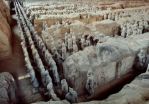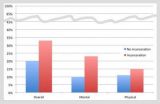(Press-News.org) Even as he conquered rival kingdoms to create the first united Chinese empire in 221 B.C., China's First Emperor Qin Shihuang ordered the building of a glorious underground palace complex, mirroring his imperial capital near present-day Xi'an, that would last for an eternity.
To protect his underworld palaces, the First Emperor issued instructions that his imperial guard be replicated, down to the finest details, in red-brown terracotta clay, poised to do battle. Thousands of these imperial guards were initially discovered in 1974; some contained patches of pigment that had survived 22 centuries buried underground, along with minute remnants of binding media that had aided in the creation of this polychrome Terracotta Army.
Efforts to conserve, and perhaps even restore, these remarkable examples of sculpture in the round from the first empire have been hampered by the failure of a series of scientific experiments to pinpoint the binding material used in applying pigments to Qin Shihuang's underground army.
More than a quarter-century ago, the United Nations Educational, Scientific and Cultural Organization inscribed the Mausoleum of the First Qin Emperor on its World Heritage List – a chronicle of the most fantastic and important cultural and historical sites around the world.
Describing the site, UNESCO experts stated: "Qin (d. 210 B.C.), the first unifier of China, is buried, surrounded by the famous terracotta warriors, at the center of a complex designed to mirror the urban plan of the capital, Xianyang. The small figures are all different; with their horses, chariots and weapons, they are masterpieces of realism and also of great historical interest."
Describing the site as "one of the most fabulous archaeological reserves in the world," UNESCO experts pointed out the immense value of investigating the technology involved in creating and coloring these lifelike warriors: "The documentary value of a group of hyper realistic sculptures where no detail has been neglected - from the uniforms of the warriors, their arms, to even the horses' halters - is enormous. Furthermore, the information to be gleaned from the statues concerning the craft and techniques of potters and bronze-workers is immeasurable."
Archaeological excavations and research conducted since the discovery of the First Emperor's polychrome army have revealed "the surfaces of the terracotta warriors were initially covered with one or two layers of an East Asian lacquer … obtained from lacquer trees," according to Hongtao Yan and Jingjing An, scientists at the College of Chemistry and Materials Science, Northwest University, in the Chinese city of Xi'an.
In an article coauthored with Tie Zhou, Yin Xia and Bo Rong, scholars at the Key Scientific Research Base of Ancient Polychrome Pottery Conservation, the State Administration for Cultural Heritage, connected with the Museum of Emperor Qin Shihuang's Terracotta Army, these researchers stated: "This lacquer was used as a base-coat for the polychrome layers, with one layer of polychrome being placed on top of the lacquer in the majority of cases."
These five scholars likewise revealed in the study, which was published in the Chinese Science Bulletin, that polychrome layers applied to these sculpted imperial guards were composed of natural inorganic pigments and binding media. These pigments have been identified as including cinnabar [HgS], apatite [Ca5(PO4)3OH], azurite [Cu3(CO3)2(OH)2] and malachite [Cu2CO3(OH)2], etc., but the precise composition of binding media used in the painting process had long eluded scientists.
Research aimed at solving this puzzle faced an array of obstacles: extremely low levels the proteinaceous binding media in the polychrome layers of Qin Shihuang's terracotta army have survived being submerged in almost six meters of water-saturated loess for more than two millennia.
"Following almost 22 centuries of storage under these conditions, the remaining pieces of original polychromy that have survived on the sculptures contain extremely small amounts of the binding media," the researchers wrote in an article titled "Identification of proteinaceous binding media for the polychrome terracotta army of Emperor Qin Shihuang by MALDI-TOF-MS."
"A large amount of the polychromy has already been lost through pillaging as well as damage resulting from fires and the long-lasting effect of water," they explained.
To solve the more than 2000-year-old enigma, these researchers used matrix-assisted laser desorption/ionization time-of-flight mass spectrometry (MALDI-TOF-MS) to identify the binding material. MALDI-TOF-MS offers high levels of sensitivity, requires only a minimal sample pretreatment process and can be used to reliably identify different types of proteinaceous material.
The researchers prepared "artificially aged" model samples by mixing different pigments with either animal glue or an adhesive concocted from free-range chicken eggs. To replicate the processes involved in the degradation of the pigments and binding media of the actual terracotta warriors, the model samples were buried in loess soil at a depth of one meter for one year.
Historical samples of the polychrome terracotta army were obtained from the Museum of Emperor Qin Shihuang's Terracotta Army in Xi'an to facilitate a comparative analysis.
Proteins were extracted from the model samples and from the historical samples, and the extracts were subjected to an ultrasonic bath treatment. The mixtures were then centrifuged and the supernatants collected. A method involving the complexation of EDTA in combination with dialysis was used to eliminate any interference in the polychrome layers taken from the historical samples. The extracted proteins were hydrolyzed with Sequencing grade trypsin to generate peptide fragment.
The binding media of the historical and model samples were analyzed by MALDI-TOF-MS, and the resulting peptide mass fingerprints of each sample were compared.
The peptide mass fingerprints of the historical samples were very similar to those of the animal glue model samples, having most peak masses in common.
The data obtained from the peptide mass fingerprints revealed that animal glue was present in the polychrome layers of Qin Shihuang's terracotta army even though this proteinaceous binding material underwent significant changes in terms of protein content during the two millennia the terracotta army was deployed underground. The binding media could be ascertained due to the fact that the peptide mass fingerprint of the animal glue proteins could be identified with certainty.
"To the best of our knowledge," wrote the five researchers, "this work represents the first account of the proteinaceous binding media from a 2200-year-old historical sample in China being identified by MALDI-TOF-MS."
INFORMATION:
This research was funded by the National Key Technology R&D Program, China (No. 2010BAK67B12 ).
See the article:
H. Yan, J. An, T. Zhou, Y. Xia, B. Rong, "Identification of proteinaceous binding media for the polychrome terracotta army of Emperor Qin Shihuang by MALDI-TOF-MS," Chin. Sci. Bull. (2014) 59(21):2574–2581.
doi: 10.1007/s11434-014-0372-9
This article was published online, in the Chinese Science Bulletin, by Science China Press and Springer-Verlag Berlin Heidelberg.
Science China Press is a leading publisher of scientific journals in China, and operates under the auspices of the Chinese Academy of Sciences. Science China Press presents to the world leading-edge advancements made by Chinese scientists across a spectrum of fields.
http://www.scichina.com/
Scientists solve 2000-year-old mystery of the binding media in China's polychrome Terracotta Army
2014-08-01
ELSE PRESS RELEASES FROM THIS DATE:
Taking the guesswork out of cancer therapy
2014-08-01
Researchers and doctors at the Institute of Bioengineering and Nanotechnology (IBN), Singapore General Hospital (SGH) and National Cancer Centre Singapore (NCCS) have co-developed the first molecular test kit that can predict treatment and survival outcomes in kidney cancer patients. This breakthrough was recently reported in European Urology, the world's top urology journal.
According to IBN Executive Director Professor Jackie Y. Ying, "By combining our expertise in molecular diagnostics and cancer research, we have developed the first genetic test to help doctors prescribe ...
Georgia Tech jailbreaks iOS 7.1.2
2014-08-01
Security researchers at the Georgia Tech Information Security Center (GTISC) have discovered a way to jailbreak current generation Apple iOS devices (e.g., iPhones and iPads) running the latest iOS software.
The jailbreak, which enables circumvention of Apple's closed platform, was discovered by analyzing previously patched vulnerabilities with incomplete fixes.
It shows that quick workarounds mitigating only a subset of a multi-step attack leave these devices vulnerable to exploitation. Patching all vulnerabilities for a modern, complex software system (i.e., Windows ...
Symbiotic survival
2014-08-01
Boulder, Colo., USA – One of the most diverse families in the ocean today -- marine bivalve mollusks known as Lucinidae (or lucinids) -- originated more than 400 million years ago in the Silurian period, with adaptations and life habits like those of its modern members. This Geology study by Steven Stanley of the University of Hawaii, published online on 25 July 2014, tracks the remarkable evolutionary expansion of the lucinids through significant symbiotic relationships.
At is origin, the Lucinidae family remained at very low diversity until the rise of mangroves and ...
Companion planets can increase old worlds' chance at life
2014-08-01
Having a companion in old age is good for people — and, it turns out, might extend the chance for life on certain Earth-sized planets in the cosmos as well.
Planets cool as they age. Over time their molten cores solidify and inner heat-generating activity dwindles, becoming less able to keep the world habitable by regulating carbon dioxide to prevent runaway heating or cooling.
But astronomers at the University of Washington and the University of Arizona have found that for certain planets about the size of our own, the gravitational pull of an outer companion planet ...
Jailed family member increases risks for kids' adult health
2014-08-01
PROVIDENCE, R.I. [Brown University] — New research shows that people who grew up in a household where a member was incarcerated have a 16-percent greater risk of experiencing poor health quality than adults who did not have a family member sent to prison. The finding, which accounted for other forms of childhood adversity, suggests that the nation's high rate of imprisonment may be independently imparting enduring physical and mental health difficulties in some families.
"These people were children when this happened, and it was a significant disruptive event," said Annie ...
2014 ESC/ESA Guidelines on non-cardiac surgery: Cardiovascular assessment and management
2014-08-01
The publication of the new joint ESC/ESA Guidelines on non-cardiac surgery: cardiovascular assessment and management introduces a number of recommendations in the field. Among other topics, the Guidelines include updated information on the use of clinical indices and biomarkers in risk assessment, and the use of novel anticoagulants, statins, aspirin and beta-blockers in risk mitigation.
Worldwide, non-cardiac surgery is associated with an average overall complication rate of between 7% and 11% and a mortality rate between 0.8% and 1.5%, depending on safety precautions. ...
Chemists develop MRI technique for peeking inside battery-like devices
2014-08-01
A team of chemists from New York University and the University of Cambridge has developed a method for examining the inner workings of battery-like devices called supercapacitors, which can be charged up extremely quickly and can deliver high electrical power. Their technique, based on magnetic resonance imaging (MRI), establishes a means for monitoring and potentially enhancing the performance of such devices.
The work, which appears in the latest issue of the journal Nature Communications, focuses on electric double-layer capacitors (EDLCs), a type of so-called supercapacitor. ...
Management of anticoagulant-associated intracerebral hemorrhage
2014-08-01
Charlottesville, VA (August 1, 2014). The Journal of Neurosurgery is pleased to announce today's publication of a supplement to the August issue entitled "Race Against the Clock: Overcoming Challenges in the Management of Anticoagulant-Associated Intracerebral Hemorrhage." Authored by Peter Le Roux, MD, Charles V. Pollack, Jr., MA, MD, Melissa Milan, MD, and Alisa Schaefer, PhD, the 20-page supplement covers the current knowledge of anticoagulant-associated intracerebral hemorrhage (AAICH) and methods in use for management of the condition. Provided by Paradigm Medical ...
Scientists warn time to stop drilling in the dark
2014-08-01
The co-authors of a new study, including two Simon Fraser University research associates, cite new reasons why scientists, industry representatives and policymakers must collaborate closely on minimizing damage to the natural world from shale gas development. Viorel Popescu and Maureen Ryan, David H. Smith Conservation Research Fellows in SFU's Biological Sciences department, are among eight international co-authors of the newly published research in Frontiers in Ecology and the Environment.
Shale gas development is the extraction of natural gas from shale formations ...
Female baby boomers with asthma? You may need help
2014-08-01
ARLINGTON HEIGHTS, Ill. (August 1, 2014) – Women over the age of 65 face numerous barriers to good health: an increased risk for obesity, greater struggles against poverty and higher rates of asthma with worse health outcomes. An article published in the August issue of Annals of Allergy, Asthma and Immunology, the scientific publication of the American College of Allergy, Asthma and Immunology (ACAAI), outlines the challenges faced by older women in treating asthma, and offers practical solutions to improve their care.
"Allergists want older women to understand that ...




